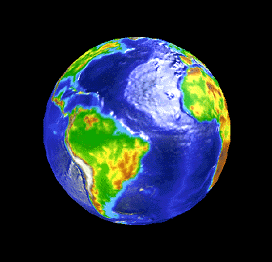The Radeon 256 is full of fancy names for features that you will see pop up on other products as well. One such feature set is ATI’s Pixel Tapestry Architecture, which is just ATI’s way of describing the 3D features their Radeon 256 architecture will offer.
If you recall, one of the big new features of NVIDIA’s GeForce was its support for Cubic Environment Mapping (CEM), which has made its way onto the Radeon 256. One of the criticisms for NVIDIA’s support of CEM was that the GeForce didn’t have the fill rate to truly take advantage of it.
In defense of NVIDIA, the GeForce didn’t need to have the fill rate to take advantage of CEM since, at the release of the product, there were no available titles that took advantage of it. The Radeon 256 should be available when the potential for games to take advantage of CEM is greater than when NVIDIA originally announced support for it last year.
The name of Matrox’s game was Bump Mapping when they announced and released their G400 series. The Expendable screenshot depicting how Environment Mapped Bump Mapping (EMBM) could be used to make water seem more like water and less like a floating texture quickly became one of the most impressive forms of eye candy ever produced by a company. Unfortunately, there was limited developer support for EMBM and in the cases where it was put to use, the performance hit was very noticeable.
 ATI’s
Pixel Tapestry Architecture includes support for all three forms of bump mapping:
Dot Product 3 (used by the Permedia 3 Create!), EMBM (used by the G400), and
the classic embossed bump mapping which most cards support. The difference
between ATI’s EMBM solution and Matrox’s is that, instead of forcing developers
to create a separate bump map texture in order to achieve the effect, the Radeon
256 applies the effect on a per pixel basis. The result is an easier time for
developers and a more efficient way of performing EMBM than Matrox’s solution.
ATI’s
Pixel Tapestry Architecture includes support for all three forms of bump mapping:
Dot Product 3 (used by the Permedia 3 Create!), EMBM (used by the G400), and
the classic embossed bump mapping which most cards support. The difference
between ATI’s EMBM solution and Matrox’s is that, instead of forcing developers
to create a separate bump map texture in order to achieve the effect, the Radeon
256 applies the effect on a per pixel basis. The result is an easier time for
developers and a more efficient way of performing EMBM than Matrox’s solution.
Another interesting feature of the Pixel Tapestry Architecture is its support for what is known as a Priority Buffer. Essentially, a priority buffer assigns each polygon or object a value depending on how far that particular object/polygon is from a light source. Using this value, the intensity of lighting effects on the polygons/objects in a scene can be adjusted so that things closer to a light source receive a harsher lighting effect while those further away receive a softer light.
This can be quite helpful when it comes to determining the resulting shadows from these light sources. What comes to mind when we talk about a priority buffer is 3dfx’s talk of soft shadows courtesy of their T-buffer.
One of the more revolutionary features included in the Pixel Tapestry Architecture is the support for 3D textures. Currently, textures are simply 2D entities used to “paint” surfaces with a certain look. For example, the walls in Quake III are simply flat surfaces covered by a texture to make the surface appear more realistic.
A 3D texture would actually be a chunk of that wall, and it would have depth to it. So theoretically, if you had a wall made from 3D textures, you could fire a rocket into the wall and blow a chunk of the wall out and have that piece actually feature some depth/texture to it. More realistic lighting is also something that 3D textures could be used for, and it’s something that id Software’s John Carmack has expressed interest in.
Applying 3D textures in a game is just like using 2D textures. The main problem in this situation is that they take up a considerable amount of memory because there is physically more information that needs to be stored.
Realistically speaking, you won’t see many (if any) games take advantage of 3D textures until sometime next year. The feature is a part of DirectX 8, and by the time it is implemented in games, we will have a new set of graphics accelerators (more powerful ones) capable of handling the additional storage requirements set forth by 3D textures.
Luckily, you can still use texture compression to help lessen the burden of 3D textures, just as we currently do with 2D textures using DXTC, S3TC and FXT1 texture compression algorithms.
Finally, to top off the Pixel Tapestry feature set, the Radeon 256 will boast support for Full Scene Anti-Aliasing and the same Motion Blur/Depth of Field effects that 3dfx’s Voodoo5 currently supports courtesy of its T-buffer. According to ATI, they only tossed these features in because 3dfx was offering them, and it didn’t hurt to offer the same; however, ATI does not believe that they are extremely important features (especially FSAA). ATI’s primary concern is being able to display higher resolution images.










0 Comments
View All Comments